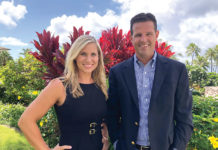By Diane Haynes Woodburn

This past January, Alexander & Baldwin, one of Hawai‘i’s original Big Five corporations, kicked off the year with a groundbreaking for its newest residential development, Kamalani, in north Kihei. The dirt-and-shovel affair also promises groundbreaking opportunity: a long-awaited and much-needed affordable housing component.
On an island where most properties are out of reach for the average first-time buyer, this is big news. We interviewed Grant Chun, vice president of A&B Properties, to learn more.
How is affordable housing defined?
It is not low-income housing, nor government-assisted. Per the County of Maui, affordable housing must be attainable to buyers whose household income is 80 to 140 percent of median income. On Maui, median income for a family of four is $76,700.
So families with a household income of $61,360 to $107,380 would qualify?
Yes.
How much will Kamalani’s affordable homes cost?
Prices will start in the high $200,000s and go up to the high $400,000s for condos and townhomes. The pricing is determined through a formula provided by the County of Maui, based on median income and prevailing interest rates.
The units will be available to the various income groups under different price points, as required by County ordinance. For those earning 80 to 100 percent of median income, homes will stay on the market at that level for ninety days. They can then move to the next income level, 100 to 120 percent of median income, for ninety days, followed by the highest level, 120 to 140 percent of median income.
If, after that time, there are still affordable homes available, the County will open the opportunity to off-island folks [who qualify for affordable housing]. After all those markets are exhausted, remaining units would go into the mainstream market. The entire process takes about a year.
What kind of demand to you expect?
This is the first time we’ve offered homes under the County’s affordable-housing ordinance. Market research tells us there is a tremendous shortage. Therefore we expect strong demand from entry-level buyers. When the first affordable units go on the market later this year, applicants will be invited to put their name on a list for the opportunity to purchase by lottery, and then vetted to see if they qualify.
What kinds of loans are available to families interested in the program?
The best are provided by banks and other lenders that work with federal programs such as Fannie Mae and Freddie Mac. These programs are designed for first-time buyers.
Are the rates more favorable for those qualifying for affordable housing?
Yes. Federally assisted loans may offer lower rates, and also lower-percentage down payment.
An important thing to know about some of these loan programs is homebuyer education. Since the economic downturn, many lenders now require the borrower to take an approved course in home buying, which includes a one-on-one counseling session and a credit report. Many folks earn enough money, but because of their lifestyle, may not qualify for a loan. The course provides information on what a mortgage is, what the costs of homeownership really are, and what responsibilities the borrower is accepting when taking out a loan. A&B is requiring first-time applicants to take such a course to be eligible for Kamalani’s sales lottery, so that when it comes time to apply for the loan, they’ll have the best chance to qualify.
Who offers these classes?
The course is currently provided through Hale Maha‘olu for $75, and is two sessions. A variety of dates are offered, plus an online version. Potential borrowers who complete the class receive certification that they have satisfied the requirement for these loans. This is a great tool, regardless of whether the borrower is interested in Kamalani or another project.
How much of Kamalani is set aside for affordable housing?
Out of 600 units, 170 in the first increment will be affordable: two- and three-bedroom condos and townhomes.
Are there rules for resale of affordable housing?
Yes. The owner is not allowed to sell the home until after a specified number of years. Owners who want to sell before that time are required to offer the unit to the County first. Additionally, the buyer may realize only 25 percent or less of the increased value during the restriction period — that is, the difference between the purchase price and the appraised value at resale. For example, if the home has increased in value from $300,000 to $400,000, the owner may sell for no more than $325,000. The intent is to encourage true first-time homebuyers and discourage speculators. After the specified time restriction, the owner may sell at market price.
Affordable units are sold at a loss to the developer. For the first-time homeowner, they can be a huge windfall — if the owner stays in the unit for the required duration.
What are the time restrictions?
Ten years for those qualifying at the first level of affordability [applicants earning 80 to 100 percent of mean income]; eight years for next level [100 to 120 percent]; and five years for the third [120 to 140 percent].
Are you working with specific lenders?
Yes. Our lead lender is Ann Sakamoto from Central Pacific Bank. Bank of Hawai‘i and American Savings are also participating.
What is your advice for families interested in affordable housing?
Take the Home Buyer Education class as soon as possible. Seating is limited, and advance registration is required. To register, call 808-856-4045, or go online at KamalaniLiving.com. The website also has information on eligibility requirements for the County’s Residential Workforce Housing.





